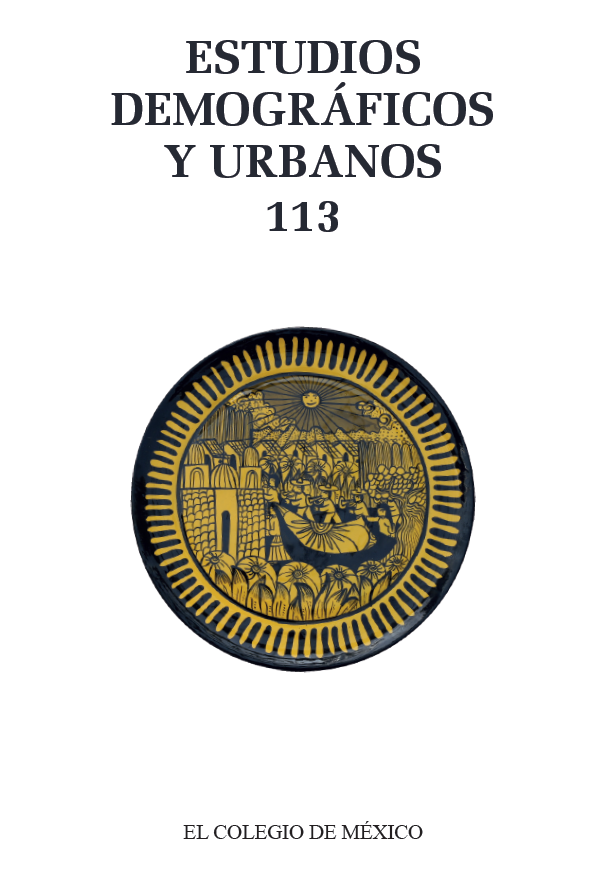Analysis of occupational transitions in Mexico. An approach based on flexible parametric model
Published 2023-07-13
Keywords
- labor market transitions,
- informality,
- unpaid care and domestic work,
- multi-state models,
- rotating panel
How to Cite
-
Abstract1089
-
PDF (español)404
-
En línea (español)94
-
EPUB (español)14
-
Kindle (español)32
-
Audio (español)14
Downloads
Copyright (c) 2022 Estudios Demográficos y Urbanos

This work is licensed under a Creative Commons Attribution-NonCommercial-NoDerivatives 4.0 International License.
Metrics
Abstract
This article analyses the transitions between formal and informal occupation, and non-occupation in Mexico, based on the microdata for the rotating panel of the National Occupation and Employment Survey from the first quarter of 2016 to the first quarter of 2017. The methodology used is based on the estimation of multi-state models. The results show great mobility in the labor market depending on the initial occupation. Regarding the explanatory factors, unpaid work has a significant impact on the risk of moving from occupation –formal or informal– to non-occupation.
References
- Aguirre, R., García Sainz, C. y Carrasco, C. (2005). El tiempo, los tiempos, una vara de desigualdad. (Serie Mujer y Desarrollo). Santiago de Chile: Comisión Económica para América Latina y el Caribe (CEPAL). https://www.cepal.org/es/publicaciones/5936-tiempo-tiempos-vara-desigualdad
- Ariza, M. y De Oliveira, O. (2014). Viejos y nuevos rostros de la precariedad en el sector terciario, 1995-2010. En C. Rabell (ed.), Los mexicanos. Un balance del cambio demográfico (pp. 672-703). Ciudad de México: Fondo de Cultura Económica. https://www.iis.unam.mx/los-mexicanos-un-balance-del-cambio-demografico/
- Bernabé, S. y Stampini, M. (2009). Labour mobility during transition: Evidence from Georgia. Economics of Transition, 17(2), 377-409. https://feb.kuleuven.be/drc/licos/publications/dp/dp206.pdf DOI: https://doi.org/10.1111/j.1468-0351.2009.00345.x
- Bigsten, A., Mengistae, T. y Shimeles, A. (2007). Mobility and Earnings in Ethiopia’s Urban Labor Markets: 1994-2004. (Working Paper). World Bank Policy Research. https://ssrn.com/abstract=972701 DOI: https://doi.org/10.1596/1813-9450-4168
- Bosch, M. y Maloney, W. F. (2006). Gross worker flows in the presence of informal labor markets. The Mexican experience 1987-2002. (CEP Discussion Paper). Centre for Economic Performance. https://doi.org/10.1596/1813-9450-3883 DOI: https://doi.org/10.1596/1813-9450-3883
- Bosch, M. y Maloney, W. F. (2010). Comparative analysis of labor market dynamics using Markov processes: An application to informality. Labour Economics, 17, 621-631. https://doi.org/10.1016/j.labeco.2010.01.005 DOI: https://doi.org/10.1016/j.labeco.2010.01.005
- Canavire-Bacarreza, G. J. y Lima, L. F. (2009). Unemployment duration and labor mobility in Argentina: A socioeconomic-based pre- and postcrisis analysis. Revista Latinoamericana de Desarrollo Económico, 12, 1-3 http://www.scielo.org.bo/scielo.php?script=sci_arttext&pid=S2074-47062009000200007&lng=es&nrm=iso
- Carrasco, C. (2001). La sostenibilidad de la vida humana, ¿un asunto de mujeres? Mientras Tanto, 82, 43-70. https://www.jstor.org/stable/27820584
- Crowther, M. J. y Lambert, P. C. (2013). Simulating biologically plausible complex survival data. Statistics in Medicine 32, 4118-4134. https://doi.org/10.1002/sim.5823 DOI: https://doi.org/10.1002/sim.5823
- Crowther, M. J. y Lambert, P. C. (2017). Parametric multistate survival models: Flexible modelling allowing transition-specific distributions with application to estimating clinically useful measures of effect differences. Statistics in Medicine 36, 1-24. https://doi.org/10.1002/sim.7448 DOI: https://doi.org/10.1002/sim.7448
- Duryea, S., Marquéz, G., Pagés, C. y Scarpetta, S. (2006). For better or for worse? Job and earnings mobility in nine middle- and low-incomecountries. Brookings Trade Forum. Global Labor Markets?, 187-209. http://www.jstor.org/stable/25063208 DOI: https://doi.org/10.1353/btf.2007.0002
- Fabrizi, E. y Mussida, C. (2009). The determinants of labour market transitions. Giornale degli Economisti e Annali di Economia, 68(2), 233-265. https://www.jstor.org/stable/41954996
- Fadejeva, L. y Opmane, L. (2016). Internal labour market mobility in 2005-2014 in Latvia: The micro data approach. Baltic Journal of Economics, 16(2), 152-174. https://doi.org/10.1080/1406099X.2016.1196872 DOI: https://doi.org/10.1080/1406099X.2016.1196872
- Flores, J. G. R., Zamora, S. y Contreras, E. (2013). Transiciones entre el trabajo formal e informal y medios de intermediación laboral en México 2005-2010. (IDB Technical Note). Banco Interamericano de Desarrollo. https://publications.iadb.org/publications/spanish/document/Transiciones-entre-el-trabajo-formal-e-informal-y-medios-de-intermediaci%C3%B3n-laboral-en-M%C3%A9xico-2005-2010.pdf DOI: https://doi.org/10.18235/0010026
- Gazier, B. y Gautie, J. (2011). The “transitional labour markets” approach: Theory, history and future research agenda. Journal of Economic and Social Policy, 14(1), 1-26. https://www.researchgate.net/publication/32224138_The_Transitional_Labour_Markets_Approach_Theory_History_and_Future_Research_Agenda
- Geskus, R. B. (2016). Data analysis with competing risks and intermediate states. Londres - Nueva York: CRC Press Taylor / Francis Group. https://www.routledge.com/Data-Analysis-with-Competing-Risks-and-Intermediate-States/Geskus/p/book/9781466570351 DOI: https://doi.org/10.1201/b18695
- Gianelli, G. C. (1991). Women’s transitions in the labour market: A competing risks analysis on German panel data. Journal of Population Economics, 9(3), 287-300. https://www.jstor.org/stable/20007509 DOI: https://doi.org/10.1007/BF00176689
- Gong, X., Van Soest, A. y Villagomez, E. (2004). Mobility in the urban labour market: A panel data analysis for Mexico. Economic Development and Cultural Change, 53(1), 1-36. https://doi.org/10.1086/423251 DOI: https://doi.org/10.1086/423251
- Hegewisch, A. y Gornick, J. C. (2011). The impact of work-family policies on women’s employment: A review of research from OECD countries. Community, Work and Family, 14(2), 119-138. https://doi.org/10.1080/13668803.2011.571395 DOI: https://doi.org/10.1080/13668803.2011.571395
- Hill, M. A. (1990). Intercohort differences in women’s labor market transitions. The American Economic Review, 80(2), 289-292. https://www.jstor.org/stable/20065
- INEGI (Instituto Nacional de Estadística y Geografía) (2017). Encuesta Nacional de Ocupación y Empleo 2016 y 2017. https://www.inegi.org.mx/programas/ENOE/15ymas/#Microdatos
- Iriarte Rivas, C. G. (2018). Unemployment transitions in the Mexican labour market and the role of job search channels. EconoQuantum 15(2), 49-72. https://doi.org/10.18381/eq.v15i2.7128 DOI: https://doi.org/10.18381/eq.v15i2.7128
- Kaiser, L. C. (2006). Female labor market transitions in Europe. Institute for the Study of Labor (IZA). http://ftp.iza.org/dp2115.pdf DOI: https://doi.org/10.2139/ssrn.901245
- Krstić, G. y Sanfey, P. (2007). Mobility, poverty and well-being among the informally employed in Bosnia and Herzegovina. Economic Systems, 31, 311-3. https://doi.org/10.1016/j.ecosys.2007.06.004 DOI: https://doi.org/10.1016/j.ecosys.2007.06.004
- Lambert, P. C. y Royston, P. (2009). Further development of flexible parametric models for survival analysis. Stata Journal, 9(2), 265-290. https://doi.org/10.1177/1536867X0900900206 DOI: https://doi.org/10.1177/1536867X0900900206
- Lehmann, H. y Pignatti, N. (2008). Informal employment relationships and labor market segmentation in transition economies: Evidence from Ukraine. (IZA Working Paper, 3269). The Institute for the Study of Labor (IZA). https://papers.ssrn.com/sol3/papers.cfm?abstract_id=1136431 DOI: https://doi.org/10.2139/ssrn.1136431
- Levy, S. (2010). Buenas intenciones, malos resultados. Política social, informalidad y crecimiento económico en México. Ciudad de México: Océano.
- Ochoa, S. M. (2016). Trayectorias laborales durante la crisis económica 2008-2009 en México. Economía Informa, 399, 34-58. http://www.economia.unam.mx/assets/pdfs/econinfo/399/03OchoaLeon.pdf DOI: https://doi.org/10.1016/j.ecin.2016.08.004
- Ortiz, L. (2005). Leaving the labour market: Event-history analysis of female workers’ transition to housework in Denmark, Germany, Great Britain and Spain. (Working Paper, 2005-1). Barcelona: Universitat Pompeu Fabra. http://hdl.handle.net/10230/273
- Pacheco, E. y Parker, S. W. (2001). Movilidad en el mercado de trabajo urbano: evidencias longitudinales para dos periodos de crisis en México. Revista Mexicana de Sociología, 63(2), 3-26. https://doi.org/10.2307/3541345 DOI: https://doi.org/10.2307/3541345
- Pagés, C. y Stampini, M. (2009). No education, no good jobs? Evidence on the relationship between education and labor market segmentation. Journal of Comparative Economics 37, 387-401. https://doi.org/10.1016/j.jce.2009.05.002 DOI: https://doi.org/10.1016/j.jce.2009.05.002
- Palmer, P. A. L. (1993). Modelo de regresión de Cox: ejemplo numérico del proceso de estimación de paramétros. Psicothema, 5(3), 38-402. http://www.psicothema.com/psicothema.asp?id=890
- Putter, H., Fiocco, M. y Geskus, R. B. (2007). Tutorial in biostatistics: Competing risks and multi-state models. Statistics in Medicine, 26, 2389-2430. https://doi.org/10.1002/sim.2712 DOI: https://doi.org/10.1002/sim.2712
- Rodríguez, C. (2013). La cuestión del cuidado: ¿el eslabón perdido del análisis económico? Revista CEPAL, 106, 23-36. https://www.cepal.org/es/publicaciones/11524-la-cuestion-cuidado-eslabon-perdido-analisis-economico DOI: https://doi.org/10.18356/9241f4b8-es
- Román, P. (2014). La dinámica familiar en relación con el mercado laboral. Revista Iberoamericana de Ciencias 1(1), 117-132. http://www.reibci.org/publicados/2014/mayo/4567480.pdf
- Román-Sánchez, Y. G., Montoya-Arce, B. J., Gaxiola-Robles-Linares, S. C. y Lozano-Keymolen, D. (2019). Los adultos mayores y su retiro del mercado laboral en México. Sociedad y Economía, 37. https://doi.org/10.25100/sye.v0i37.7823 DOI: https://doi.org/10.25100/sye.v0i37.7823
- Ros, Jaime. (2017). La economía mexicana en 2016: tendencias y perspectivas. Revista de Economía Mexicana. Anuario UNAM, 2, 2-38. http://herzog.economia.unam.mx/assets/pdfs/econmex/02/01Ros.pdf
- Royston, P. y Parmar, M. K. B. (2002). Flexible parametric proportional-hazards and proportional-oddsmodels for censored survival data, with application to prognostic modelling and estimation of treatment effects. Statististics in Medicine, 21, 2175-2197. https://doi.org/10.1002/sim.1203 DOI: https://doi.org/10.1002/sim.1203
- Schmid, G. (2008). Full employment in Europe. Managing labour market transitions and risks. Cheltenham: Edward Elgar. DOI: https://doi.org/10.4337/9781848441477
- Schmid, G. (2017). Transitional labour markets: Theoretical foundations and policy strategies. En Palgrave Macmillan (eds.), The New Palgrave Dictionary of Economics. Londres: Palgrave Macmillan. https://doi.org/10.1057/978-1-349-95121-5_3050-2 DOI: https://doi.org/10.1057/978-1-349-95121-5_3050-1
- Slonimczyk, F. y Gimpelson, V. (2013). Informality and mobility: Evidence from Russian panel data. (Discussion Paper). The Institute for the Study of Labor (IZA). http://ftp.iza.org/dp7703.pdf DOI: https://doi.org/10.2139/ssrn.2349026
- Sosa, M. y Román, R. (2015). Participación y tiempo en actividades cotidianas de hombres y mujeres vinculados al mercado laboral en México. Sociedad y Economía, 29, 63-89. DOI: https://doi.org/10.25100/sye.v0i29.3918
- Tansel, A. y Ozdemir, Z. A. (2015). Determinants of transitions across formal / informal sectors in Egypt. (Discussion Paper, 8773). The Institute for the Study of Labor (IZA). https://mpra.ub.uni-muenchen.de/id/eprint/61183 DOI: https://doi.org/10.2139/ssrn.2554921
- Vega Núñez, A. P. (2017). Análisis de las transiciones entre la formalidad y la informalidad en el mercado de trabajo ecuatoriano. Revista de la CEPAL 123, 85-100. https://doi.org/10.18356/281be5be-es DOI: https://doi.org/10.18356/281be5be-es


